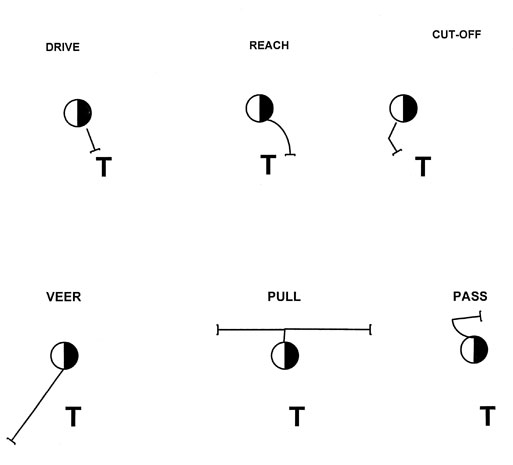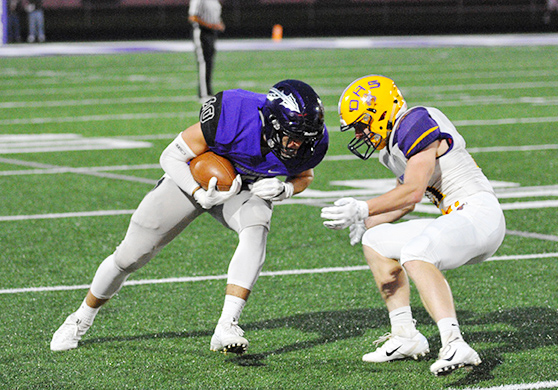Football: Training your linemen in the 43 defense
Click here to read part one of this article.
There are four basic combination blocks that we cover in our daily practices. Depending on the type of offense we face each week, we determine which ones to put more emphasis on — double team, scoop-on, scoop-off, and pull with a down block.
As in our battle of one key, the emphasis on teaching our players how to read each block is determined by what our man on does. We use the terms visual key and pressure key in assisting our guys to recognize which combo block they are getting. The visual key is always the man on and the pressure key is the closest lineman to our shade.
We use the terms visual key and pressure key in assisting our guys to recognize which combo block they are getting. The visual key is always the man on and the pressure key is the closest lineman to our shade.
For example, our man is a three-technique tackle and we get a double team, our battle of 1 (guard) or visual key, will give us a drive block and our pressure key, near gap lineman (tackle) gives us a down block. We will concentrate on putting the drive block on his heels and getting our hat into the crack and sitting on the near lineman (pressure key).
You will often find this combo block easier to defense if your lineman is aggressive to the drive block. We will always have our three-technique play with his gap hand down and gap foot back to help him defeat the double team.
Because his gap foot is back, his first step allows him to sit on the double team more effectively, when it’s already inside the tackle’s down block.
We separate zone blocks into scoop-on and scoop-off to further assist us with our progressions in recognizing and stopping an offensive play. Most inside zone teams utilize two offensive blockers to work against a defensive lineman and a linebacker. Vs scoop-on, our battle-of-one is going to give us a cut-off block as he punches our inside breastplate and looks to find the second level player.
Diag. 5, Combo Blocks

- Scoop On: An inside zone play
- Scoop-Off: A stretch play (outside zone)
- Double-Team: A hard drive block by our man-on
- Pull-Down Block: Executed mostly by our interior linemen
If we attack this with our man on keys, we can squeeze him down the LOS and make it difficult for him to come off to the backer. This forces the pressure key or near lineman to come off to the backer. It’s not what they want to do and it increases our success against the zone play.
Teams that run the outside zone play will attempt to get up to the second level quickly, leaving the near lineman to overtake our defensive lineman. This is easily recognizable by the flat step of our man on, similar to a veer block, except that our pressure key is coming to overtake us (veer = no pressure key).
We will attempt to grab the cloth of our man and turn our shoulders in the same direction, opening up our hips to the play and giving our pressure key our back. From here, we rip the pressure key, using our outside arm and pursuing down the LOS to the ball carrier, gaining depth as we do.
Diag. 6, Another “Battle of One” Keys

The last combination block we spend time on against two-back teams is the pull with a down block. The reason I refer to this as a combination block is because we are incorporating a pressure key and must work against two linemen to simulate this block.
We always use the pulling lineman’s direction to initiate our next move. I will use the three-technique tackle most of the time to get him used to feeling where the down block is in relation to his shoulder and hip.
The coaching point here is to determine whether or not to stay on the pulling guard’s hip (inside pull only) or cross face vs. the center’s down block. If we get a good get-off, and the center’s weight is on our hip (behind us), we will continue on our path behind the puller to the ball carrier.
If the center takes a good step and we feel his weight on our shoulder (front), we will drop our inside hand and cross the center’s face to run down the ball carrier.
In the 43, we will always have a backside LB to account for the cutback. That’s the reason I allow our players to cross face.
As with the man on blocks, we will use a progression and a “fit” principle to teach our defensive linemen how to recognize and defeat the different combo blocks.
It is extremely important to use the predicted vs unpredicted method in teaching how to defend combo blocks. For example, with scoop-on, we will set up a defensive lineman in a “fit” position against his man on in a cut-off block simulation and have the pressure key (near lineman) already in a scoop position.
On the whistle, we tell each lineman to continue the block and, at the same time, have the defensive lineman try to defeat what his man on is giving him. In this case, it’s a cut-off that squeezes down his man on pressure key and prevents him from climbing to the second level.
We then run the predicted drill at half speed vs. the scoop-on and progress to full speed until the kids can properly recognize and defeat the block.
We use this method for all of the combo blocks. Once we have covered the “fit” drill, we continue with the unpredicted drill and show them all four-combo blocks.
Again, you can incorporate another drill at the finish, whether it’s an angle tackle, fumble or finish through to a cone.
Repetition is the key to success with the big men on the defensive line. I cannot stress enough the importance of playing with your hands and keeping your pad level lower than your opponent to achieve success vs. the run.
Pass rush
Quoting one of my defensive brethren, “The greatest play in defensive football is the sack-forced fumble.” We use this mentality at WPI because we all know how important momentum is to the game. Nothing can change the tempo of a game more than a hit leading to a turnover.
It’s equally as damaging to your opponent in terms of momentum, which is why we stress this every day with our pass-rush drills. To achieve this, no matter what you teach in terms of pass-rush techniques, you will notice that the great pass rushers find an extra gear to turn on as they rush the QB. No matter the drill, we always emphasize a great finish such as a 5-yard burst to a pop-up bag or cone to simulate this aspect of our pass rush.
 It’s easy for a guy rushing the edge to back off because of the separation from his man, only to find that the offensive lineman has moved his feet and reset his hands, or the QB feels pressure and leaves the pocket. You find you have a lot more work to do.
It’s easy for a guy rushing the edge to back off because of the separation from his man, only to find that the offensive lineman has moved his feet and reset his hands, or the QB feels pressure and leaves the pocket. You find you have a lot more work to do.
Just as with the run game, our beginning in teaching pass rush is the get-off. We will use two drills to warm up for our pass rush progressions.
The first is a Jet drill and the second a Rabbit drill. In the Jet drill, we start two guys off with a hand down and the same foot back, elevated off the ground to just above their hips.
On movement, they will drive the up-leg forward and see if they can get their foot a few inches past where the down hand had been. This is an exaggerated first step, but it gets them thinking about getting a jump on an O-lineman in a passing situation.
The Rabbit drill involves the use of one of our four blocks to simulate an offensive lineman in a two-point stance 2 yards off the LOS. Our defensive linemen are reacting to the movement of the offensive man, who is attempting to backpedal for 5 yards without the defensive lineman touching him. We want our lineman to take a great first, up field step and get to a half-man on the O-lineman with both hands to the outside shoulder before he gets to 5 yards.
Again, we’re teaching the lineman to have a longer first step vs. high-hat pass sets. From here, we begin the fit and progression period of our pass rush. We use several different moves with counters built in, and I think it’s the coach’s responsibility to find which move works best for each individual and have him perfect it.
Our ends or edge rushers always set up their pass rush off their speed rush-mentality, and our inside big men set up their pass rush off the bull rush. This fits into one of the most important aspects of being a great rusher — how to get the offensive lineman out of his power position.
In other words, what are we going to do to get an offensive lineman off his heels, turn his shoulders, move his feet, and lean or lunge. I only know of two methods: speed and power.
Speed & power
The speed rush we teach is the Tomahawk speed. We will flex our ends outside the blocker roughly 1 yard and, on the snap, have them drop to about 4.5 – 5 yards back and drive their inside hand down on the outside hand of the offensive lineman. This simulates a “chopping” motion and drops their shoulder to the hip of the O-lineman, ripping up hard with their elbows high and driving into the back or side of the O-lineman.
We will use the fit drill to finish the last part of this rush by placing a defensive lineman into either a man or a shield with his inside hand down and the same shoulder on the hip.
On the whistle, the defensive lineman finishes the remainder of the move by ripping his elbow high, leaning on his man or shield, and finishing with a 5-yard burst to a cone or coach.
It’s important to teach your players to go for the ball with their up field arm and secure the sack with the other. Use a pop-up bag for the QB and hold a ball out opposite the bag, allowing the player to run through the bag as he knocks down the ball.
We will sometimes run the same drill from the other side and have the rusher “scoop” the fumble, incorporating more than one aspect in a drill to save time.
 This is an example of how you can teach your defensive lineman to get an O-lineman out of his power position because he must move his feet to accommodate for your speed.
This is an example of how you can teach your defensive lineman to get an O-lineman out of his power position because he must move his feet to accommodate for your speed.
The counter to the Tomahawk speed is the Ninja spin, and we use the same fit drill, only this time having the defensive lineman in a defeated position on the man or shield (QB or bag is underneath our path) and finish through the counter with the same burst drill at the end.
Watch for players who want to spin first before getting pressure up field. The counter is used only if we get too far up field or are in a bad position on our man. If you spin too shallow, you give the QB the outside lane to either run or pass outside of your rush.
The power move we teach is called the Club/flip — an attempt to get to the half-man and take him out of his power position. But we are using brute force to accomplish this.
We use a fit/progression drill to teach this move. We start with the defensive lineman in a right or left shade on the O-lineman, who has his inside hand on our shoulder. From here, we knock the arm of the O-lineman off with either a cut or swipe move of our inside hand.
As we do this, we start to flip our hips, pointing our butt to the backfield and clubbing the outside shoulder of the man until we are perpendicular to the O-lineman and stop.
Here is where you can coach the kids up on particular techniques. Go twice to each side and rotate. Next, do the same movements except to continue to shuffle our feet past the O-lineman so our butt is facing the QB and stop.
Next, execute the finish from the end of the last progression with a rip or punch to separate from the O-lineman.
Lastly, we will do all three parts of the move at once again finish with a burst to a bag, cone or coach for 5 yards. Use the same finishers as with the Tomahawk to work strip, sack or fumble.
With any pass-rush move, you must always coach your players to have a plan for every down in case they get a high-hat read. Since they must already have a plan of attack, they need not hesitate. One second of hesitation could mean the difference in a QB having the necessary time to throw downfield and hurt you.
It’s always a good idea to teach pass-rush moves off a bull rush for your nose guard, as his man on will most likely get the help of a center and you will want the middle of your rush to stay on course and not get washed.
We use a lot of hand-to-hand combat drills for this as well as a Butt-Bull technique. The butt-bull starts out from the bull rush, but as the O-lineman starts to take away a side of your rush lane, you should use a similar technique defeating a reach block.
Use your power arm technique to turn the hips of the O-lineman and flip your hips at the same time, you should shuffle your feet to get beyond his hip and finish with a rip or punch to the QB.
You have now given your players a couple of techniques with built in counters to pressure the QB. Work them everyday and your people will become great rushers.
Remember, if your opponent throws the ball 10 times a game and you’re bringing four, that’s 40 opportunities to make a big play and change the tempo of a game, increasing your chances for success.
15 daily coaching points
- Stop the run on the way to the QB.
- Always be prepared to take away a drive block
- Always have a pass rush plan if you get a high hat.
- First step is always up field unless you’re slanting.
- Man on key is referred to as “Battle-Of-One”.
- Play with your hands
- Eyes in the palms of your hands.
- Even up your stagger when slanting.
- Elongate your stance if it’s a passing down.
- Always allow your second step to take you out of a block.
- Win and look through your gap.
- Never rush the passer with your shoulders square to the LOS.
- Finish every play.
- Always go for the ball if you’re the second guy in on a tackle.
- Study your opponent on film and look for “Tells.”





